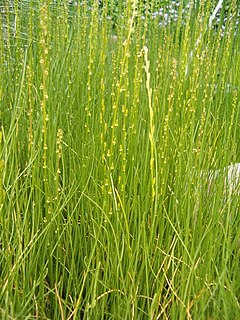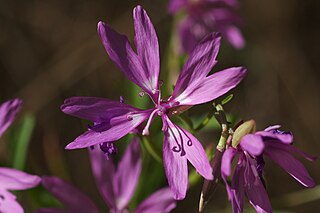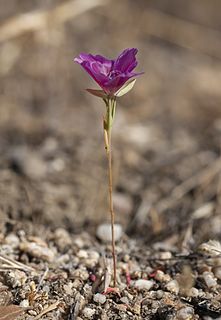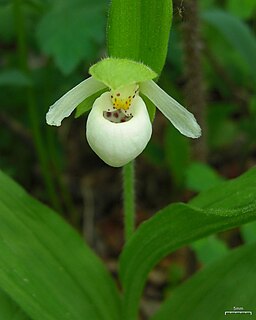
Clarkia is a genus within the flowering plant family Onagraceae. Over 40 species are currently classified in Clarkia; almost all are native to western North America, though one species is native to South America.

Clarkia amoena is a flowering plant native to western North America, found in coastal hills and mountains from British Columbia south to the San Francisco Bay Area.

Triglochin is a plant genus in the family Juncaginaceae described by Carl Linnaeus in 1753. It is very nearly cosmopolitan in distribution, with species on every continent except Antarctica. North America has four accepted species, two of which can also be found in Europe: Triglochin palustris and Triglochin maritima. Australia has many more.

Chaenomeles speciosa, the flowering quince, Chinese quince, or Japanese quince, is a thorny deciduous or semi-evergreen shrub native to eastern Asia. It is taller than another commonly cultivated species, C. japonica, usually growing to about 2 m. The flowers are usually red, but may be white or pink. The fruit is a fragrant but hard pome that resembles a quince.

Clarkia rubicunda is a flowering plant endemic to California. It is found mostly on the Central Coast part of the state. The plant is known by the common names ruby chalice clarkia and farewell to spring.

Clarkia breweri is a species of wildflower known by the common names fairy fans and Brewer's clarkia. This rare plant is endemic to California, where it is known from only seven counties in the central part of the state. It produces short stems under 20 centimeters in height and sparse, narrow leaves. The distinctive flowers have four pink to lavender petals, each about 2 centimeters long and wide, with 3 odd lobes, the middle lobe being long and spoon-shaped.
Clarkia lingulata is a rare species of wildflower known by the common name Merced clarkia. This plant is endemic to Mariposa County, California, where it is known from only two sites near the Merced River.

Clarkia purpurea is a species of wildflower known by the common names winecup clarkia, winecup fairyfan, and purple clarkia.

Clarkia unguiculata is a species of wildflower known by the common name elegant clarkia or mountain garland. This plant is endemic to California, where it is found in many woodland habitats. Specifically it is common on the forest floor of many oak woodlands, along with typical understory wildflowers that include Calochortus luteus, Cynoglossum grande and Delphinium variegatum. C. unguiculata presents a spindly, hairless, waxy stem not exceeding a meter in height and bears occasional narrow leaves. The showy flowers have hairy, fused sepals forming a cup beneath the corolla, and four petals each one to 2.5 centimeters long. The paddle-like petals are a shade of pink to reddish to purple and are slender and diamond-shaped or triangular. There are eight long stamens, the outer four of which have large red anthers. The stigma protrudes from the flower and can be quite large. Flowers of the genus Clarkia are primarily pollinated by specialist bees found in their native habitat "Clarkias independently developed self-pollination in 12 lineages."

Grevillea concinna, commonly known as red combs or elegant grevillea, is a species of flowering plant in the family Proteaceae and is endemic to the south-west of Western Australia. It is a spreading to erect shrub with mostly linear to narrow wedge-shaped leaves sometimes with a sharp point on the tip. Flower colour varies with subspecies.

Clarkia biloba is a species of flowering plant in the evening primrose family known by the common name twolobe clarkia and two lobed clarkia.

Clarkia franciscana is a rare species of flowering plant in the evening primrose family known by the common name Presidio clarkia. It is endemic to the San Francisco Bay Area of California, where it is known only from two populations at the Presidio of San Francisco and three occurrences in Oakland. The plant is known only from serpentine soils.

Clarkia jolonensis is an uncommon species of flowering plant in the evening primrose family known by the common name Jolon clarkia. It is endemic to Monterey County, California, where it is known from the woodlands of the Central Coast Ranges.

Clarkia williamsonii is a species of flowering plant endemic to California, where it is known from the forests and woodlands of the northern and central Sierra Nevada foothills.

Clarkia pulchella also known as pinkfairies, ragged robin, and deerhorn clarkia is a species of flowering plant in the family Onagraceae.

In molecular biology, this protein domain belongs to the terpene synthase family (TPS). Its role is to synthesize terpenes, which are part of primary metabolism, such as sterols and carotene, and also part of the secondary metabolism. This entry will focus on the N terminal domain of the TPS protein.

Cypripedium passerinum is a species of lady's slipper orchid known by the common names sparrow's-egg lady's-slipper, spotted lady's-slipper, and Franklin's lady's-slipper.

Leslie David Gottlieb (1936–2012) was a United States biologist described by the Botanical Society of America as "one of the most influential plant evolutionary biologists over the past several decades". He was employed at the University of California, Davis for 34 years, and published widely. In addition to his primary work in plant genetics, Gottlieb was an advocate for rare and endangered plant conservation.
C. concinna may refer to:

Frank Harlan Lewis was an American botanist, geneticist, taxonomist, systematist, and evolutionist who worked primarily with plants in the genus Clarkia. He is best known for his theories of "catastrophic selection" and "saltational speciation", which are closely aligned with the concepts of quantum evolution and sympatric speciation. The concepts were first articulated in 1958 by Lewis and Peter H. Raven, and later refined in a 1962 paper by Lewis in which he coined the term "catastrophic selection". In 1966, he referred to the same mechanism as "saltational speciation".

















